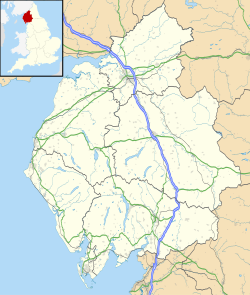St Mary's Church, Ambleside
Appearance
| St Mary's Church | |
|---|---|
 | |
| 54°25′51″N 2°58′00″W / 54.430848°N 2.966588°W | |
| Location | Ambleside |
| Country | United Kingdom |
| Denomination | Church of England |
| Website | amblesidechurch.org.uk |
| Architecture | |
| Heritage designation | Grade II* |
| Architect(s) | George Gilbert Scott |
| Style | Gothic Revival |
| Years built | 1850s |
| Administration | |
| Province | York |
| Diocese | Carlisle |
| Archdeaconry | Westmorland |
| Clergy | |
| Bishop(s) | James Newcome |
| Pastor(s) | Beverley Lock |
St Mary's Church is in Ambleside, Cumbria, England. It was built in the 1850s to a design by George Gilbert Scott in the Gothic Revival style.[1] Notable features include its stone spire.[2][1][3]
Interior
There is a mural depicting rushbearing (a traditional ceremony in Ambleside which is held on the first Saturday in July). The mural was created by Gordon Ransom during the Second World War when the Royal College of Art was based in Ambleside.[2][4] The vicar of Ambleside, Henry Adamson Thompson, is depicted on the right hand side of the mural.
Burials
Burials include Annie, Sophia and Mary Louisa Armitt.[5]
References
- ^ a b St Mary's Church
- ^ a b "Church of St Mary". Historic England. Retrieved 2017-08-01.
- ^ Bingham, Roger (2011). "Guide book reveals". Westmorland Gazette. Retrieved 16 March 2014.
- ^ Leslie Duxbury (2008), Bohemians in Exile: The Royal College of Art in Ambleside, 1940-1945. "Bohemians in Exile" was also the title of a 2011 exhibition at the Armitt Museum.
- ^ Eileen Jay, ‘Armitt, Mary Louisa (1851–1911)', Oxford Dictionary of National Biography, Oxford University Press, 2004 accessed 13 Nov 2015
External links
Wikimedia Commons has media related to St Mary, Ambleside.

